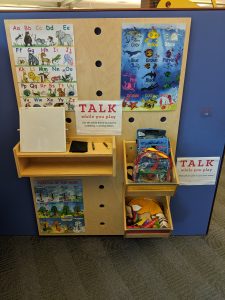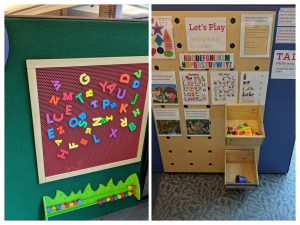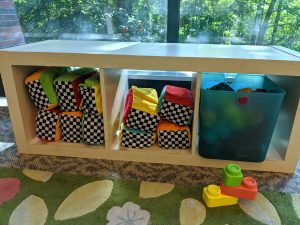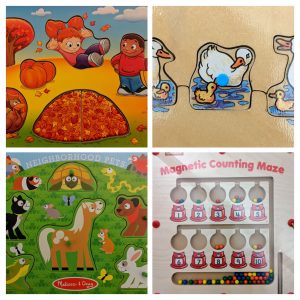Discover educational toys in our pretend play spaces. We’ve changed over to a new theme for Fall 2019, “Let’s Play School.”
Learning Junction
You can help your child sort blocks by color, size or shape. Sorting is a great early math skill and helps little ones make sense of their world by thinking about which things are alike and different.
Decide what to pack in your lunch from a variety of play food options. Giving a child a chance to plan and make choices allows them to lead their play and helps to build confidence.
Use the white board to practice scribbling or writing letters like the ones printed on the alphabet poster. Scribbling can help little ones develop coordination, creativity and literacy skills.

In another section, you will find activities based around learning shapes, colors and the alphabet. Discover the math posters to promote learning ordinal numbers, counting, and graduated sizes.
Your little one can play with a pretend clock, although keep in mind–learning to tell time is for children over 5 years old! Practice numbers on the hopscotch rug, shapes in the puzzle, and letter recognition on the magnetic board.
Baby/Toddler Area
Help your baby or tot find a variety of blocks, some soft and large, others more connectable. Stacking blocks, then knocking them over, helps little ones understand cause and effect (important STEM learning) as well as develop fine and gross motor skills.
Find the puppet theater and see the different puppets we have put there. Puppet play can help children express emotions that might be bottled up, practice emotional empathy. They can also build narrative skills, such as learning that stories have a beginning, middle, and end.
Puzzle Table
As always, our puzzle table is a big draw and you will find new puzzles there. Puzzles build fine motor dexterity as well as vocabulary. Sit beside your child and help them name the different pieces. Our magnetic counting maze puzzle requires the use of a magnetic wand, mimicking a pencil so children have to practice their grip.
Look for the parent tips near each area and remember, you are your child’s first and, in our opinion, best teacher!
Happy learning!

